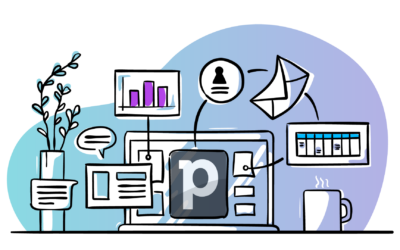Last updated: Aug 7th, 2025
I love being a part of a small marketing team. At least on most days.
But then there are days when there don’t seem to be enough hours to get it all done. And no matter how much you push yourself to put in more hours (or daydream about having double the manpower and triple the budget), the work keeps piling up.
Sounds familiar? Chances are it does.
According to research by Airtable, 86% of marketing leaders say their current workload is creating stress for their team. Further, the average marketing leader spends 13 hours per week on manual, operational tasks. Not very efficient, is it?
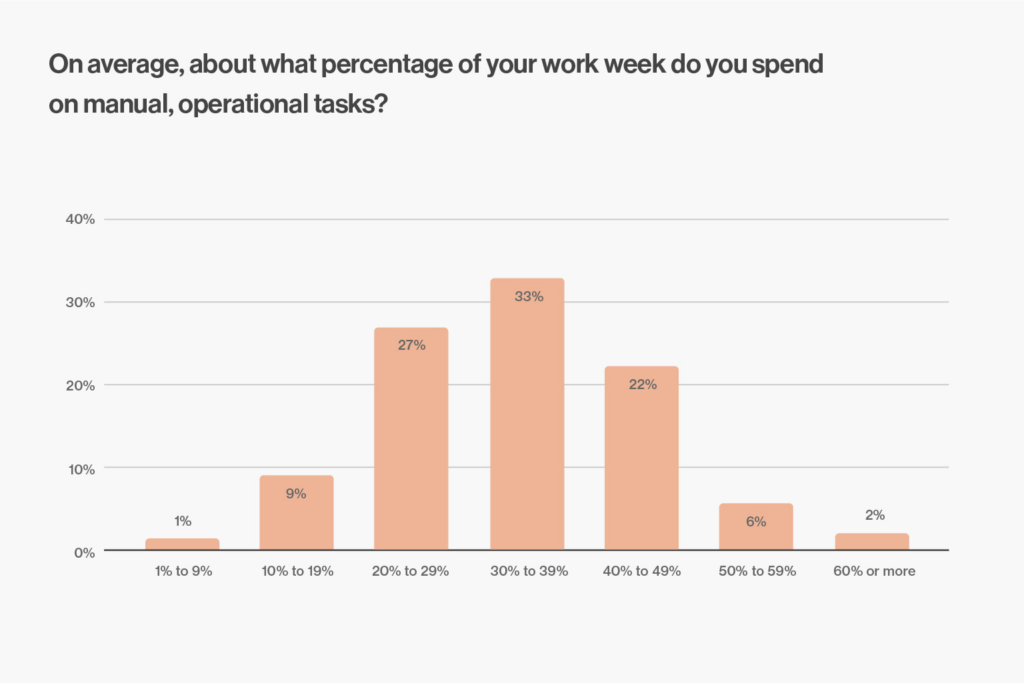
And yet, help is closer than ever: a 2024 American Marketing Association survey found that 85 % of marketers who already use generative-AI tools say those tools have “slightly or significantly” increased their productivity.
So, what can be done to combat these issues and reduce the workload? This article covers the 101 of efficient marketing. Read on or jump to the sections that are most relevant to you:
- What can you do to be a more efficient marketer? First, ask these two questions.
- “Should I be doing this?” aka prioritizing marketing activities like a pro
- “How should this get done?” aka executing marketing in the most efficient ways possible
What can you do to be a more efficient marketer? First, ask these two questions.
Typically, a marketing team runs on a structure of set goals and plans for execution: from creative ideation, prioritization of ideas to running campaigns and continuous monitoring, analysis of results, followed by iteration.
For efficient execution, you can start by asking yourself the two following questions:
- Should I be doing this?
- How should this get done?
The first question begs an evaluation of ideas and brutal prioritization. This will help you focus on the most impactful activities and minimize the fear of not doing the gazillion other things you could be doing.
Answering the second question means looking at the processes of executing the activities and making sure the way you go about doing the activities is the best, most efficient way to do them.
“Should I be doing this?” aka prioritizing marketing activities like a pro
Here at Outfunnel, we evaluate and prioritize ideas following the RICE framework, a version of the relatively widespread ICE framework. ICE looks at the potential Impact, Confidence and Ease (or in some versions, Effort) of an idea, and the R in RICE simply adds Reach to the equation.
So, the ICE framework helps you sift out ideas that will have high Impact, high Confidence (i.e. chances of success), and high Ease of implementation, meaning it will not take up too much of your resources, i.e. money or time.
Or, like Michael Taylor from ladder.io puts it:
“Rather than deciding via the HiPPO method (Highest Paid Person’s Opinion), ICE ranking lets the best ideas rise to the top, no matter where they came from.”
For us, adding the R for Reach made sense because we want to make sure we can scale our efforts to reach as many people as possible.
Additionally, you can add different multipliers for each of the factors, depending on your circumstances. For example, if you have a decent pool of resources, then Ease can have a lower multiplier. We’ve added more weight to Confidence because if we know similar tactics or strategies have worked for us or others in our network before, there’s a significantly higher chance for success.

“How should this get done?” aka executing marketing in the most efficient ways possible
There’s no single technique or framework that can guide efficient marketing execution (or at least, I haven’t found one yet). But there are two things you can rely on for saving a ton of time: delegation and automation.
Marketing efficiency excellence part 1: Delegation
As the marketing department of a company, you likely have a key role to play in demand generation, lead generation, lead nurturing, sales enablement, customer onboarding and retention, everything related to the brand, and possibly even product or service design.
And as a small team, you likely don’t have the expertise or skills necessary for all of these down to a T. So, you must be realistic about what you can and cannot do.
I consider myself a generalist, with a knack for content marketing, SEO and partner marketing. However, my responsibilities at Outfunnel not only include these chunks of work, but also expand beyond these three fields.
So, I’ve made sure I have a small army of collaborators, agencies and freelancers to help me execute our ambitious marketing plans:
- Content marketing — 3 freelance copywriters with different strengths to help produce content (although I still sometimes write content as well, like in the case of this blog post)
- SEO — a relatively small boutique agency* for white hat link building & technical SEO support
- Design & development — a small boutique agency* for creating marketing collateral and our public pages, and a freelance illustrator for creating unique illustrations
- PPC — a small boutique agency* that audits and improves the PPC campaigns we create
*A note on the “small boutique” part. I’ve found working with agencies where my points of contact are the ones doing the work is more efficient than working with agencies with more layers of hierarchy and dedicated people for every step of the process.
Additionally, we use various expert freelancers on a one-off basis as necessary. I’ve found Advisable super helpful for such cases—it’s helped draw on world-class expertise on a pay-by-hour basis.
P.S. More on how I’ve managed Outfunnel’s marketing as a team of one in this episode of The Growth Hub Podcast.
Marketing efficiency excellence part 2: Automation
Automating tasks and processes allows you to outsource everyday busywork, so you have more time to do strategic and creative work that actually moves the needle.
According to a report by Zapier, marketers most often automate the following tasks and processes: team communication (46%), identifying and targeting customers (42%), scheduling email sends (38%), sending tailored messages (31%), managing subscriber database (29%) and notifying their team of events (29%).
Although I’ve never automated notifications about events to my team, I can definitely vouch for all the other categories.
Below, you’ll find the top automations that can make your work more efficient, according to me and the rest of Outfunnel’s team. After all, we specialize in making sure your marketing processes are efficient (and effective).
1. Automate lead capture for marketing (and sales)
If you’re doing this marketing thing right, you’re probably generating a number of leads for your business every day. How do these end up in your marketing lists? How do the qualified leads end up in your CRM for salespeople to see? If you’re passing incoming leads on to your various tools manually, you’re wasting precious time.
Let’s say your main form of lead capture happens via contact forms on landing pages. You can use automation to make sure these leads get copied over to the company CRM. Do a quick Google search with the name of your web form tool and CRM + “integration” and you’ll likely find several tools that will help you.
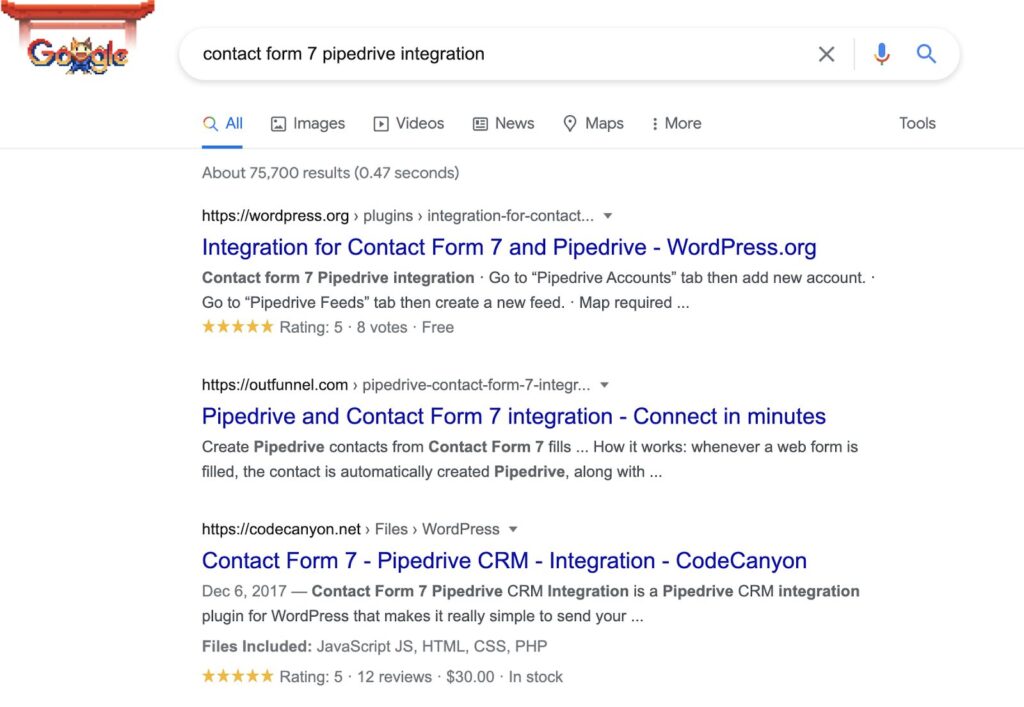
Pro tip: some automation tools are more powerful than others. Do your research thoroughly and don’t simply choose the cheapest (or free) option. Additional features like custom field mapping, passing on files from lead capture to CRM or recording detailed data about the source of the lead can be super useful, depending on your specific business needs.
Pro tip 2: Some form builders (e.g., Typeform + OpenAI plug-ins) can now score the sentiment and purchase intent of a form submission the moment it arrives, routing high-intent leads straight to sales while low-intent leads enter a nurturing sequence.
2. Set up truly automated campaigns
According to Airtable’s Marketing Trends Report, 80% of marketing leaders claim that the volume of campaigns, requests, and content that marketing needs to deliver on has increased over the last year.
The only way to keep up is to automate the campaigns as much as possible. Here at Outfunnel, for example, we’re fans of automated campaigns that get triggered based on data changes in the CRM. In fact, automating our user onboarding emails helped us win back 80% of our time.
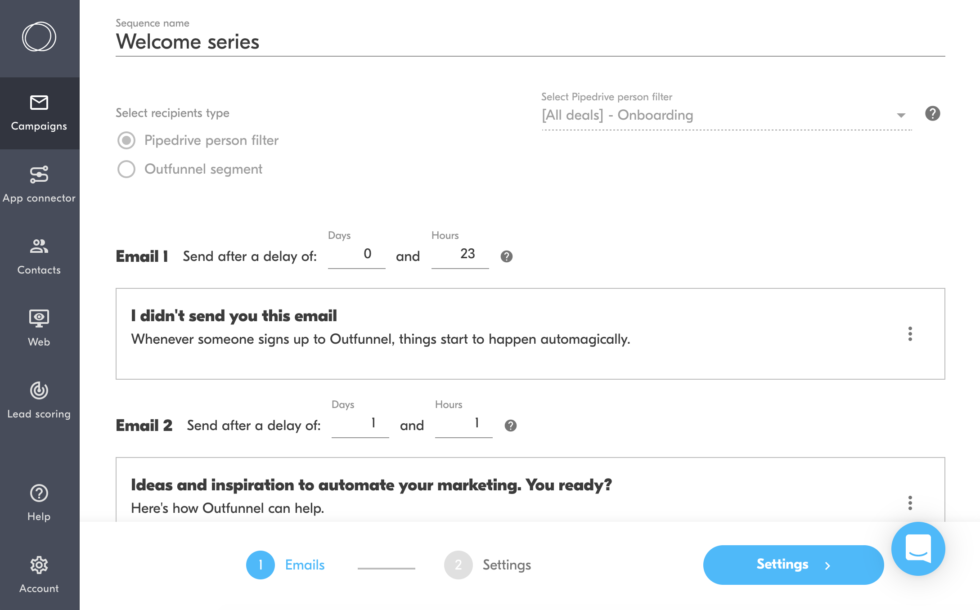
Depending on your lead generation, lead nurturing and customer onboarding processes, you can set up a number of such drip email campaigns and then sit back and monitor the results. The options are pretty much limitless, but we’ve put together an article outlining 12 drip email trigger ideas to get your imagination running.
Another area of marketing automation that we have not ventured into much (yet) is setting up automated campaigns to target warm leads with display ads.
Spoiler alert: we have an integration that will help do this, e.g. set up a Facebook ad campaign that targets people who are in a certain stage in your CRM. As the people move through that stage in the CRM, the audience in Facebook Ad manager would then be automated automatically.
3. Keep sales & marketing contact lists in sync aka never copy-paste lists again
From first contact to a sale and beyond, your leads go through various stages of the customer lifecycle. And if you know a thing or two about marketing, you’re not sending the same marketing messages to contacts in all the different stages.
However, often the data about a lead moving between the stages lives in a sales tool rather than in your marketing automation tools. So, how do you make sure your mailing databases are up to date, 24/7?
By connecting your CRM and marketing automation contact lists. This can be quite straightforward if your company uses an all-in-one sales and marketing suite, or you can set up a native or third-party integration to automatically have the contacts kept up to date.
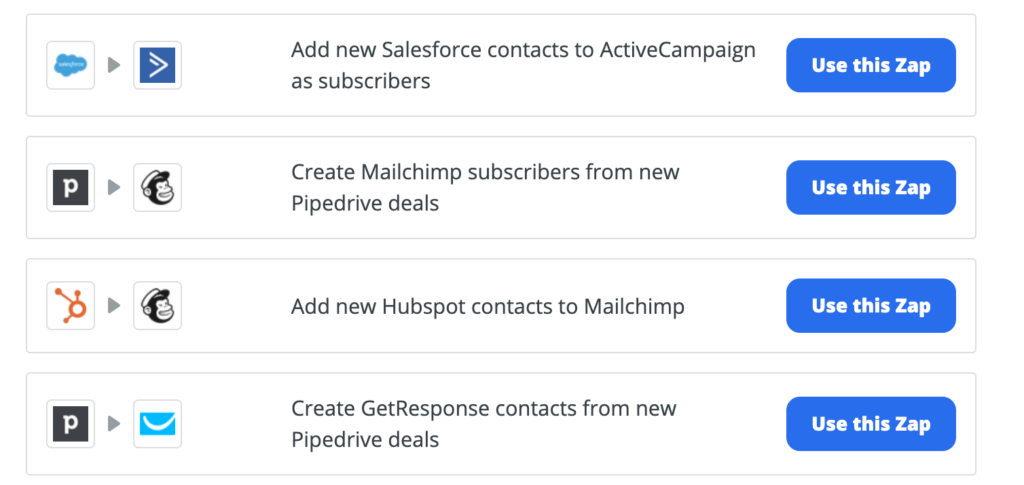
Zapier and its alternatives like Outfunnel and Make (previously Integromat) are some of the data connectors that offer integrations between CRMs and marketing tools.
Regardless of the setup specifics, the win in efficiency is huge. You can configure your marketing campaigns to be sent to audiences defined in the CRM, so they will start and stop based on data changes in the CRM. You’ll never have to export-import lists again and can send out campaigns with full confidence that the lists are up to date.
In other words, you’ll minimize the time spent on contact management.
The most common use case for such automation in B2B marketing is, of course, email automation. But increasingly, companies are discovering the power of such automations for advertising campaigns as well.
Whatever your channel, such automations let you define and set up campaigns once, and then just sit back and monitor the results.
4. Automate marketing reporting
Ahh, data and analytics. If you’re anything like me, you love digging through numbers to see how your work is performing.
The challenge? There’s so much data in so many different sources that digging through it could easily fill my working days and more. Automating marketing reporting can be a major source of efficiency, especially as your numbers grow.
At Outfunnel, we’re in the middle of setting up marketing analytics that would provide us insights and analytics in a truly automated way, so it’s something we haven’t excelled in, at least not yet. So, perhaps I’ll follow up on this once it’s all done. For now, I can just say I can’t wait for when it’ll be done. Getting it set up in a useful way is no easy task.
Marketing efficiency excellence part 3: Putting AI to work
While automation moves data, AI creates, predicts and converses—unlocking a new layer of efficiency.
Generate copy & visuals in minutes
AI writing assistants such as ChatGPT, Jasper, and Claude can now produce on-brand headlines, body copy, and even SEO-optimized meta descriptions in seconds.
Pair them with image generators like Midjourney or DALL-E and you have an end-to-end creative pipeline that turns a rough prompt (“Summer sale for eco-friendly sneakers”) into polished ad creative before your coffee cools.
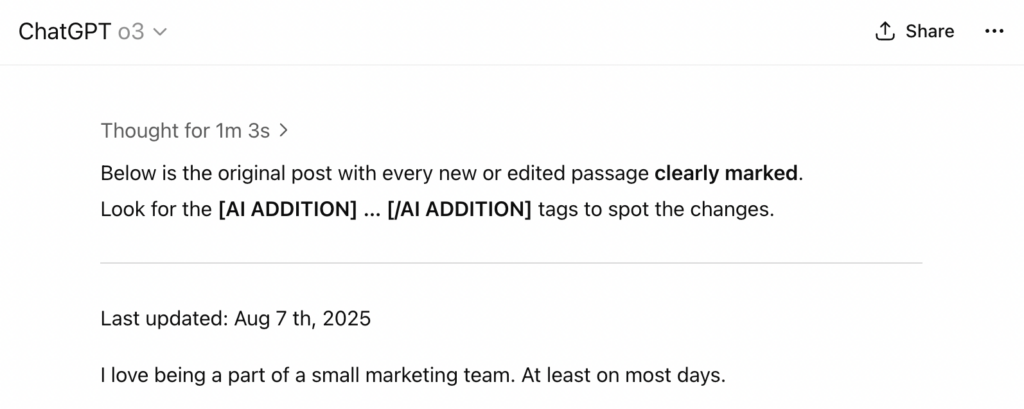
The trick is to feed the model clear guardrails—voice-of-brand guidelines, examples of past campaigns, target keywords—so you spend your time refining, not rewriting. Most teams report cutting first-draft production time by 50–80 %, freeing designers and writers to focus on high-impact polish and concept work.
Draft data-driven outlines and briefs
Research-heavy content (think white papers, pillar posts, or pitch decks) often stalls because someone has to hunt down stats, trends, and citations. Modern AI research copilots query multiple data sources simultaneously, surface fresh figures, and suggest logical narrative structures.
Start with a question—“What are the 2025 B2B SaaS retention benchmarks?”—and the tool returns curated datapoints, competitor angles, and a recommended section flow. Attach that auto-generated outline to your brief, and subject-matter experts can jump straight into filling gaps and adding perspective, shaving hours off your production calendar.
Predict who will buy next
Predictive lead scoring models embedded in CRMs and customer-data platforms analyze thousands of attributes—product usage, email engagement, firmographic shifts—to score each contact’s likelihood to convert or churn.
Instead of blanket nurturing, you can route high-propensity leads directly to sales and trigger win-back flows for accounts displaying early warning signs. Because the model recalibrates after every interaction, it often surfaces “hidden gem” prospects that a purely rules-based approach would miss, helping lean teams squeeze more revenue from the same pipeline.
Spin up chatbots that handle FAQs
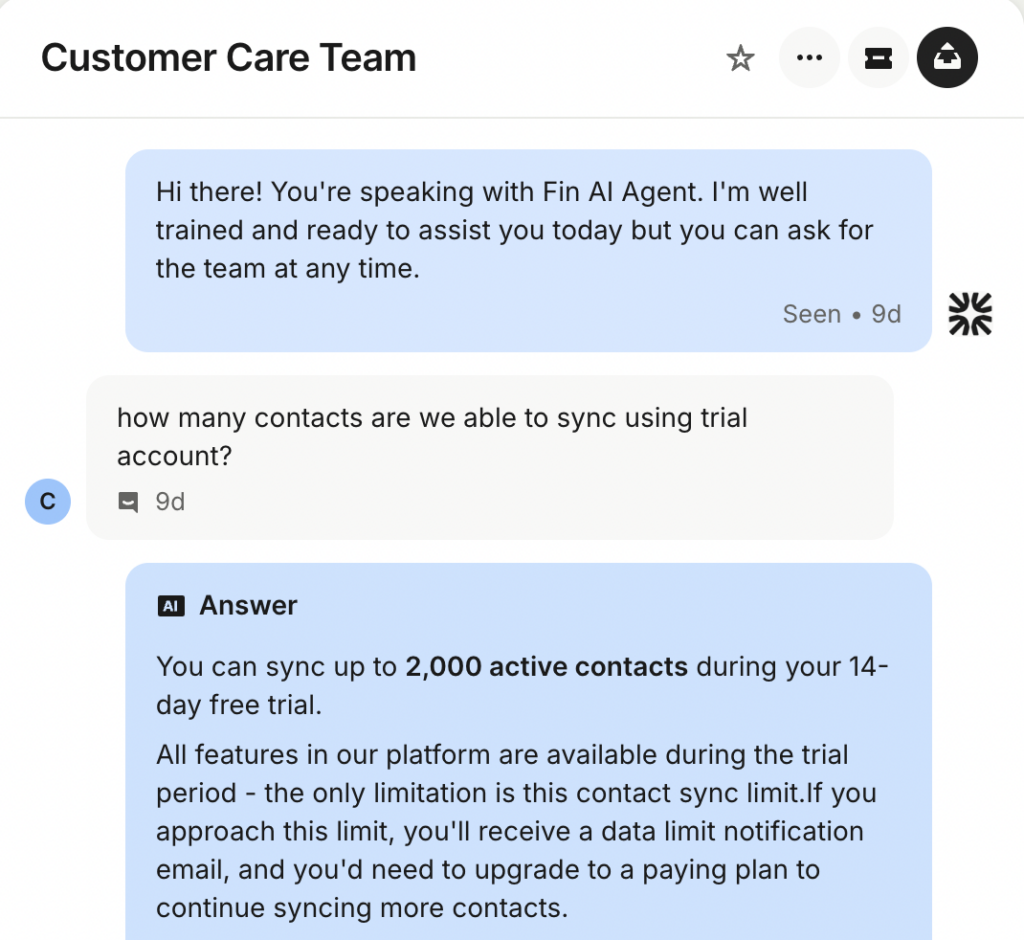
AI chatbots have evolved from brittle decision trees to natural-language agents capable of resolving a wide swath of pre-purchase and post-purchase questions. By ingesting your help-center articles, product docs, and order-status API, a bot can instantly tell a visitor “How long does shipping to Germany take?” or a customer “Why did my last invoice increase?”—no human handoff required. The payoff: marketing and support inboxes shrink, live-agent latency drops, and the user experience feels always-on, even when your team is off the clock.
| AI use case | Time saved | Example tool(s) |
|---|---|---|
| Generate first-draft copy & images | 30 – 90 min per asset | ChatGPT, Jasper, Midjourney |
| Rapid research & content outlines | 1 – 2 h per article | Perplexity AI, Claude 3 |
| Predictive audience building | Continuous | HubSpot Predictive, Optimove, Meta |
| Real-time chat & email support | 40-60 % deflection | Intercom Fin, Ada |
| Voice-over & video editing | Up to 90% of post-production time | Descript, ElevenLabs |
Closing notes: Wait, all this automation will cost me how much?
Okay, let’s talk about money.
It’s true that you will have to take out your credit card and pay for automations like the ones mentioned above. And no one’s budgets are limitless.
However, implementing all of the abovementioned automations does not have to cost you more than 100-300USD per month, if you choose tools and subscription plans geared for SMBs.
If each marketer in the EU earns roughly €38/hour, saving just eight hours a month with software tools covers a typical $30-100 plan several times over.


